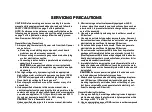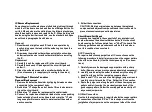
SERVICING PRECAUTIONS
SERVICING PRECAUTIONS
CAUTION: Before servicing receivers covered by this
CAUTION: Before servicing receivers covered by this
service
service
manual and its supplements and addenda, read and
manual and its supplements and addenda, read and
follow the
follow the
SAFETY PRECAUTIONS
SAFETY PRECAUTIONS
on page 3 of this publication.
on page 3 of this publication.
NOTE
NOTE
: If unforeseen circumstances create conict between
: If unforeseen circumstances create conict between
the
the
following servicing precautions and any of the safety precautions
following servicing precautions and any of the safety precautions
on page 3 of this
on page 3 of this
publication, always follow the safety precau-
publication, always follow the safety precau-
tions. Remember: Safety First.
tions. Remember: Safety First.
General Servicing Precautions
General Servicing Precautions
1. Always unplug the receiver AC power cord
1. Always unplug the receiver AC power cord
from the AC power
from the AC power
source before;
source before;
a. Removing or reinstalling any component, circuit board
a. Removing or reinstalling any component, circuit board
module or any
module or any
other receiver assembly.
other receiver assembly.
b. Disconnecting or reconnecting any receiver electrical plug
b. Disconnecting or reconnecting any receiver electrical plug
or other electrical connection.
or other electrical connection.
c. Connecting a test substitute in parallel with an electrolytic
c. Connecting a test substitute in parallel with an electrolytic
capacitor in the receiver.
capacitor in the receiver.
CAUTION
CAUTION
: A wrong part substitution or incorrect polarity
: A wrong part substitution or incorrect polarity
installation of electrolytic capacitors may result in an explo-
installation of electrolytic capacitors may result in an explo-
sion hazard.
sion hazard.
2. T
2. T
est high voltage only
est high voltage only
by measuring it with
by measuring it with
an appropriate
an appropriate
high voltage meter or other voltage measuring device (DVM,
high voltage meter or other voltage measuring device (DVM,
FETVOM, etc) equipped with a suitable high voltage probe.
FETVOM, etc) equipped with a suitable high voltage probe.
Do not test high voltage by "drawing an
Do not test high voltage by "drawing an
arc".
arc".
3. Do not spray chemicals on or near
3. Do not spray chemicals on or near
this receiver or any of its
this receiver or any of its
assemblies.
assemblies.
4. Unless specied otherwise in this service manual, clean
4. Unless specied otherwise in this service manual, clean
electrical contacts only by applying the following mixture to the
electrical contacts only by applying the following mixture to the
contacts with a pipe
contacts with a pipe
cleaner, cotton-tipped stick or comparable
cleaner, cotton-tipped stick or comparable
non-abrasive applicator; 10 % (by volume) Acetone and 90 %
non-abrasive applicator; 10 % (by volume) Acetone and 90 %
(by volume) isopropyl alcohol (90 % -
(by volume) isopropyl alcohol (90 % -
99 % strength)
99 % strength)
CAUTION
CAUTION
: This is a ammable mixture.
: This is a ammable mixture.
Unless specied otherwise in this
Unless specied otherwise in this
service manual, lubrication
service manual, lubrication
of contacts in not required.
of contacts in not required.
2. After removing an electrical assembly equipped with ES
2. After removing an electrical assembly equipped with ES
devices, place the assembly on a conductive surface such as
devices, place the assembly on a conductive surface such as
aluminum foil, to prevent electrostatic charge buildup or expo-
aluminum foil, to prevent electrostatic charge buildup or expo-
sure of the assembly.
sure of the assembly.
3. Use only a grounded-tip soldering iron
3. Use only a grounded-tip soldering iron
to solder or unsolder
to solder or unsolder
ES devices.
ES devices.
4. Use only an anti-static type solder removal device. Some sol-
4. Use only an anti-static type solder removal device. Some sol-
der removal devices not classied as “anti-static” can generate
der removal devices not classied as “anti-static” can generate
electrical charges sufcient to damage ES devices.
electrical charges sufcient to damage ES devices.
5. Do not use freon-propelled chemicals. These can generate
5. Do not use freon-propelled chemicals. These can generate
electrical charges sufcient to damage ES devices.
electrical charges sufcient to damage ES devices.
6. Do not remove a replacement ES
6. Do not remove a replacement ES
device from its protective
device from its protective
package until immediately before you are ready to install
package until immediately before you are ready to install
it.
it.
(Most replacement ES devices are packaged with leads elec-
(Most replacement ES devices are packaged with leads elec-
trically shorted together by conductive foam, aluminum foil or
trically shorted together by conductive foam, aluminum foil or
comparable conductive material).
comparable conductive material).
7. Immediately before removing the protective material from the
7. Immediately before removing the protective material from the
leads of a replacement ES device, touch the
leads of a replacement ES device, touch the
protective mate-
protective mate-
rial to the chassis or circuit assembly into which the device will
rial to the chassis or circuit assembly into which the device will
be installed.
be installed.
CAUTION
CAUTION
: Be sure no power is
: Be sure no power is
applied to the chassis or cir-
applied to the chassis or cir-
cuit, and observe all other safety precautions.
cuit, and observe all other safety precautions.
8. Minimize bodily motions when handling unpackaged replace-
8. Minimize bodily motions when handling unpackaged replace-
ment ES devices. (Otherwise harmless motion such as the
ment ES devices. (Otherwise harmless motion such as the
brushing together of your clot
brushing together of your clot
hes fabric or the lift
hes fabric or the lift
ing
ing
of your
of your
foot from a carpeted oor can generate static electricity suf-
foot from a carpeted oor can generate static electricity suf-
cient to damage an ES device.)
cient to damage an ES device.)
General Soldering Guidelines
General Soldering Guidelines
1. Use a grounded-tip, low-wattage soldering iron and
1. Use a grounded-tip, low-wattage soldering iron and
appropri-
appropri-
ate tip size and shape that will
ate tip size and shape that will
maintain tip temperature within
maintain tip temperature within
the range or 500 °
the range or 500 °
F to 600 °F.
F to 600 °F.
2. Use an appropriate gauge of
2. Use an appropriate gauge of
RMA resin-core solder composed
RMA resin-core solder composed
of 60 parts tin/40 parts lead.
of 60 parts tin/40 parts lead.
Содержание 42LB550A
Страница 13: ......
Страница 19: ......
Страница 22: ......
Страница 49: ...Appendix Exchange PSU LED driver No Light Dim Light Dim Light Dim Light No picture Sound Ok ...





































